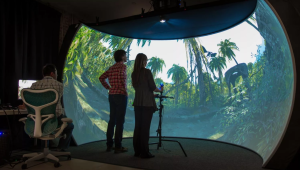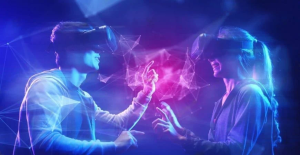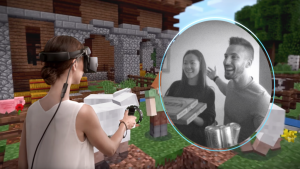Introduction
Virtual reality is no longer a niche hobby. In 2025, VR transforms how we play games, watch movies, attend concerts, and connect with friends. New headsets offer sharper visuals, richer sound, and more natural controls. AI generates dynamic worlds that adapt to you. Haptic suits let you feel every punch and breeze. Social VR spaces host live events across continents. These advances push VR from novelty to mainstream entertainment. In this article, we explore the top emerging VR technologies shaping entertainment in 2025. We explain key innovations, real-world use cases, and tips for creators and users. By the end, you will see how VR will redefine fun, storytelling, and socializing this year.
What Is VR Entertainment in 2025?
Virtual reality entertainment uses headsets and controllers to immerse you in digital worlds. Unlike flat screens, VR surrounds you with 360-degree visuals and sound. You can look around freely and interact with objects. In 2025, VR combines powerful graphics, AI, and sensory feedback. This blend creates a sense of presence—feeling you are truly “there.” Content ranges from first-person games and virtual cinemas to guided museum tours and social hangouts. As technology improves, VR experiences feel more realistic and engaging, making it a major entertainment platform.
Immersive Display Advances

High-resolution, low-latency displays are crucial for VR comfort and realism.
MicroOLED and MiniLED Panels
New headsets use MicroOLED and MiniLED screens that pack more pixels into each eye view. In 2025, many devices offer 4K per eye resolution. This higher pixel density cuts the “screen door” effect so tiny gaps between pixels vanish. Colors are more vivid, and contrast improves, making virtual scenes pop with life.
Foveated Rendering
Foveated rendering works with eye-tracking to boost performance. The system renders the sharpest detail where you look and lowers quality in your peripheral vision. This reduces graphics workload, allowing smoother frame rates on less powerful hardware. As a result, headset size and power demands shrink, while visuals stay crisp.
Haptic Feedback and Tactile Interaction
Feeling virtual objects deepens immersion beyond sight and sound.
Wearable Haptic Gloves
In 2025, haptic gloves use vibration motors and force feedback to simulate touch. When you grasp a virtual ball, the gloves tighten slightly around your fingers. Textures like rough stone or smooth metal register through tiny actuators. This tech works in gaming, virtual shopping, and remote training, letting you “feel” digital items.
Full-Body Haptic Suits
Advanced haptic suits cover the torso, arms, and legs with vibration nodes. During an action game, you might feel a punch on your shoulder or the rumble of a virtual car engine. The suits sync with in-game events, heightening excitement. They also serve in virtual fitness, where trainers can guide proper form with gentle taps or pulses.
Haptic Feedback Chairs
Special seats integrate vibration, heat, and motion to match VR scenes. Watching a roller-coaster simulation, the chair tilts and rumbles with every drop. In a horror VR experience, sudden cold air and chair shudders add real scares. These chairs bring VR into arcades and home theaters alike.
Spatial Audio and 3D Sound

Sound shapes your sense of space and action direction.
Object-Based Audio
Instead of fixed stereo channels, object-based audio places sounds in virtual 3D space. With headphones or room-based speaker arrays, you hear footsteps behind you or a bird to your left. This layering adds realism to VR games and movies. In 2025, object-based formats like MPEG-H gain support across platforms.
Biometric Sound Adjustment
New headsets scan your ear shape and hearing profile to tailor audio. Algorithms boost frequencies you struggle to hear and improve clarity. The result is fully personalized, immersive audio without needing external hearing tests.
AI-Driven Content and Procedural Worlds
Static worlds can feel stale. AI brings dynamic, personalized VR experiences.
Generative AI Worlds
Generative models now create landscapes, buildings, and entire levels on the fly. You explore endless forests or cityscapes without downloading huge game files. AI populates these worlds with items, stories, and NPCs that adapt to your actions, making each session unique.
Smart NPC Behavior
AI-powered NPCs react in lifelike ways. They remember interactions and change their mood based on your choices. A shopkeeper might offer you a discount if you helped them earlier, or avoid you if you caused trouble. This depth of behavior enriches VR role-playing and social simulations.
Personalized Storylines
AI analyses your in-game decisions and crafts branching narratives. This means two players in the same VR title may experience different stories. The system tracks choices and builds scenes that match your play style, increasing replay value and user engagement.
Social VR and Metaverse Integration

VR connects people across distances for shared experiences.
Persistent Virtual Worlds
Metaverse platforms offer ongoing worlds where your avatar lives between sessions. You can attend concerts, meetings, or movie nights with friends. These environments support voice chat, gestures, and virtual items that you collect or trade.
Live VR Events
In 2025, more artists perform live in VR venues. Fans watch concerts in virtual arenas with front-row views. Interactive features let attendees cheer, dance, and even meet the performer for a quick chat. Sports leagues host VR watch parties where you can see stats and angles no TV can show.
Collaborative Creation Spaces
VR tools allow groups to build art, models, and projects together in real time. Architects sketch buildings side by side from continents apart. Musicians compose tracks on a shared virtual stage. These creative hubs blend productivity with social fun.
Wireless and Standalone VR Headsets
Tetherless VR is key to freedom and ease of use.
5G and Wi-Fi 6E Streaming
Bandwidth-hungry VR apps stream from cloud servers over 5G or Wi-Fi 6E. This approach powers high-end graphics without heavy onboard chips. You put on a light headset and experience powerful PC-like VR with minimal latency.
Inside-Out Tracking
Modern headsets use onboard cameras to track your position rather than external sensors. This simplifies setup and lets you move in any space. You can use VR in your living room or a small office without mounting base stations.
Battery and Heat Management
Improved battery tech and cooling systems extend standalone headset sessions. In 2025, many devices last three to four hours per charge, enough for long gaming or meeting sessions. Quick-swap batteries and fast-charge docks minimize downtime.
Mixed Reality and Pass-Through

Blending real and virtual worlds offers new entertainment forms.
High-Fidelity Pass-Through
New headsets provide color pass-through cameras with minimal lag. You can see your real surroundings and then switch seamlessly into VR overlays. This mixed-reality mode lets you play with virtual objects on your real desk or hold virtual pets in your living room.
Interactive MR Experiences
Location-based entertainment venues use mixed reality for immersive storytelling. You walk through a historic site while VR layers reconstruct past events around you. Escape rooms now include holographic puzzles superimposed on real walls.
Future Trends and Challenges
While VR grows fast, challenges remain.
Accessibility and Comfort
Headset weight and cost still hinder mass adoption. Manufacturers aim to cut weight under 300 grams and prices below $300. Soft-fit head straps and better lens designs will reduce eye strain and motion sickness.
Content Quality and Standards
With many platforms, content quality varies. Industry groups push for open standards in graphics, audio, and user data privacy. Consistent guidelines help consumers and developers alike.
Social and Psychological Impact
Extended VR use raises questions about mental health. Sessions over two hours may cause disorientation or social isolation. Developers plan safe break reminders and mixed-reality modes to avoid negative effects.
Table: Emerging VR Tech in 2025
| Technology | Key Benefit | Example Use Case |
|---|---|---|
| MicroOLED Displays | Sharp visuals, no screen door effect | 4K per eye gaming |
| Haptic Gloves | Touch and force feedback | VR object manipulation |
| Spatial Audio | 3D sound placement | Immersive horror or music apps |
| Generative AI Worlds | Infinite, dynamic environments | Procedural open-world VR games |
| Social VR Events | Shared live experiences | Virtual concerts and sports watch |
| 5G Streaming Headsets | High-end VR without PC tethering | Cloud-streamed VR training |
| Mixed Reality Pass-Through | Blend real and virtual seamlessly | Interactive museum tours |
Tips for Creators and Users

Creators should optimize graphics for foveated rendering to save resources.
Use modular design in AI worlds so updates can add content easily.
Test haptic feedback carefully to avoid discomfort or interference.
Users should take breaks every 30–45 minutes to rest eyes and mind.
Ensure good play space with at least two meters of clearance for safety.
Conclusion
Emerging VR technologies in 2025 push entertainment into new realms. High-resolution displays, advanced haptics, spatial audio, and AI-driven worlds make experiences richer and more personal. Social VR and mixed reality blend physical and digital lives, letting fans attend live shows and build with friends from anywhere. While challenges in cost, comfort, and content quality remain, rapid innovation promises smoother, lighter, and more affordable headsets. As the ecosystem grows, both creators and users will find endless new ways to play, learn, and connect in virtual spaces.
Call-to-Action
Ready to dive into next-gen VR? Explore the latest headsets and apps today. Join virtual concerts, build AI worlds, and feel the future of entertainment!












